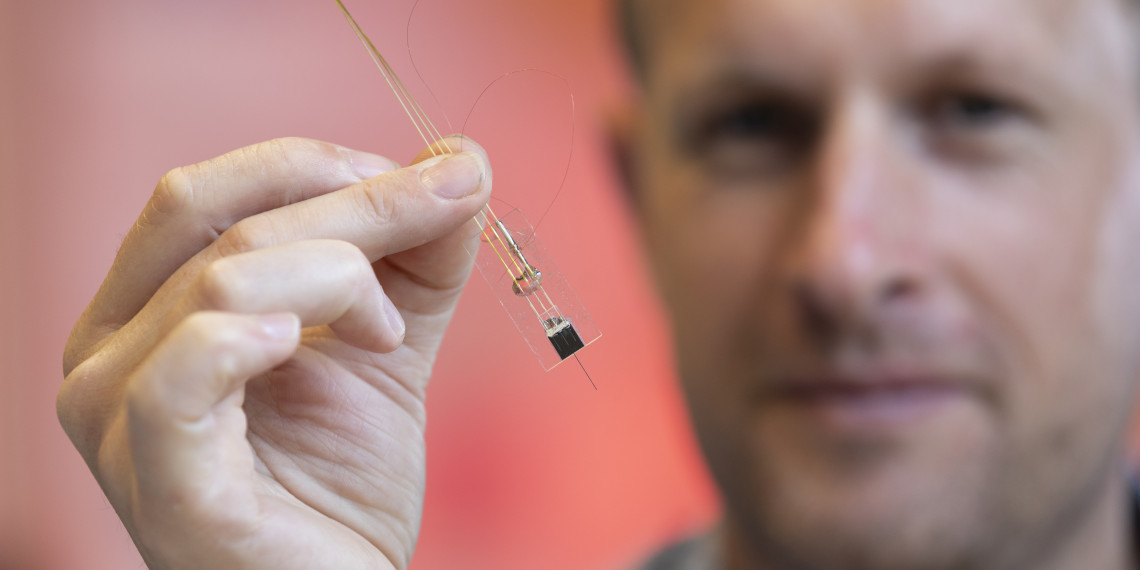‘Migraine is a common condition found in twenty-five percent of women and circa twelve percent of men. Although we are nowhere near finding a cure, neurologists can treat the condition better when we understand how the episodes occur,’ Odijk explains. He is part of the BIOS Lab-On-Chip group and is in charge of the ‘Micro- and nanodevices for Chemical Analysis’ theme. He ended up working on the migraine research via his fellow scientist Albert van den Berg, who won the Spinoza award in 2009. ‘Albert got to talking about migraine with two other winners that year: Michel Ferrari, famous migraine specialist, and Marten Scheffer, who is conducting research into tipping points in complex systems.’
Avalanche
Researching those tipping points that make the brain go haywire requires far more accurate tools than what is currently available in medical science. ‘During a migraine episode, the entire brain goes crazy. A small disruption creates a snowball effect and in some cases even an avalanche. People who suffer from such severe episodes that they see an aura around everything and even experience flashes of light are probably undergoing a wave of depolarisation throughout their entire brain. Even after the episode is over, its effects are felt for days, because the neurons struggle to recover. We have not yet found an answer to the question of why the system is disrupted so severely.’
'hormone changes can trigger a migraine'
One thing that is clear, however, is that hormone changes can trigger a migraine (‘Since having her first baby, my sister’s migraine episodes have become far less frequent.’), just like stress and an irregular sleeping pattern. ‘However, our current tools are not accurate enough to tell us exactly what happens during a migraine attack and how that extremely complex biochemical interplay between ions, neurons and neurotransmitters is disrupted exactly. Although you can make MRI and CT scans, those only show activity from the outside. What we really want is to know how the chemicals inside the brain function without this requiring an invasive procedure.’
A look inside the brain
In order to take a closer look at the brain’s chemical processes without any dangerous procedures, Odijk and his research group, which collaborates with the University Medical Centre in Leiden, developed a needle that is designed to extract neurotransmitters and electrical signals in the brain. These neurotransmitters are the brain’s chemical messengers. The needle is as thick as a human hair and contains three miniscule channels with apertures the size of a bacteria, making them invisible to the naked eye. ‘With this needle, you can very carefully suck up neurotransmitters and other molecules found in cerebral fluid, without taking out any cellular matter or pieces of cells.’
‘Science is all about the long run’
Once they did that, they had to overcome a new challenge. ‘You can imagine that, after being extracted, the fluids are no longer in the same order that they were in inside the brain. They are jumbled, as it were. Simply put, we have developed a method that uses miniscule quantities of oil to separate the fluids inside the needle. Using enzymes that turn the neurotransmitters into hydrogen peroxide, we can make the neurotransmitters visible with a fluorescent liquid.’
The long run
We should not expect spectacular result any time soon. For now, Odijk and his partners of the University Medical Centre in Leiden are simply excited about having a research system that works properly. Once they achieved that, it could be tested on mice. ‘Of course, that does not tell you all you need to know. A mouse’s brain is very different from a human brain. In mice, the migraines are triggered instead of occurring spontaneously. There is a lot we still have to improve about our research to make it scientifically valuable. We do not know a lot about how an episode is triggered. However, we have taken the first step towards the development of a useable research tool. Science is all about the long run.’
Odijk has not lost any of his motivation, though, if only because migraines are so common: a quarter of all women between the ages of 25 and 45 have them, as do twelve percent of the men in that age group. ‘The direct medical costs and their absence at work result in half a billion to one billion euros in damage every year, which does not even take into account the effects migraine has on the patients themselves.’
 Other conditions
Other conditions
Odijk expects his biochemical brain research to ultimately benefit the research into other neurological diseases as well. ‘We are entirely focused on migraines at the moment, but you can image that a tool this accurate can also be used to study what happens inside the brain of people with Alzheimer’s or Parkinson’s, for example.’
Odijk expects the major breakthrough to occur when the biological reality can be simulated with an organ on a chip, grown from human stem cells. ‘A brain-on-a-chip would allow us to gather information in a far more accurate manner. It might not replace the use of mice entirely, but it would certainly complement it. However, all that is still in its infancy at the moment.’



 Other conditions
Other conditions



